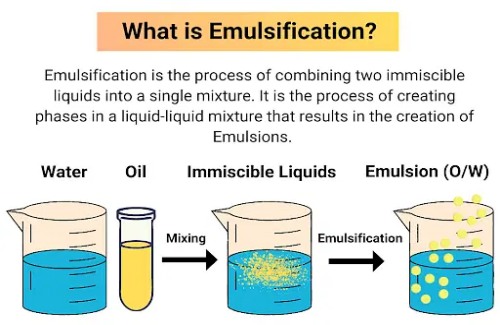The Science of Emulsifier In Food Made Simple
Why It Is Necessary to Incorporate an Emulsifier in Food for Optimum Preference and Top Quality
Emulsifiers play a vital role in food manufacturing by ensuring the secure mixing of immiscible fluids, such as oil and water. They lower interfacial tension, which avoids the separation of active ingredients and contributes to a consistent structure. This not just enhances mouthfeel yet additionally influences taste perception. Comprehending the necessity of emulsifiers reveals deeper insights right into their function and relevance in cooking applications. What ramifications does this have for food technology and consumer choices?
Recognizing Emulsifiers: The Basics
Emulsifiers play an essential role in food scientific research, working as representatives that promote the blending of 2 immiscible liquids, such as oil and water. These substances possess both hydrophilic (water-attracting) and hydrophobic (water-repelling) residential properties, which enable them to maintain solutions. Usual emulsifiers include lecithin, located in egg yolks and soybeans, and mono- and diglycerides, acquired from fats.
The Science Behind Emulsification
When 2 immiscible fluids are integrated, the process of emulsification becomes fundamental for accomplishing a steady mixture. Emulsification entails dispersing one liquid within an additional, usually oil in water or vice versa. This process takes place via mechanical frustration, which damages the bigger droplets right into smaller sized ones, consequently boosting the area. However, without the visibility of emulsifiers, these beads would integrate, causing separation.
Emulsifiers are molecules with hydrophilic (water-attracting) and hydrophobic (water-repelling) buildings. Their one-of-a-kind structure enables them to decrease the interfacial tension in between both immiscible fluids, maintaining the solution. This stablizing prevents splitting up and boosts the harmony of texture and flavor. The communications at the molecular level are vital for keeping the integrity of the solution, guaranteeing that foodstuff keep their preferred uniformity and taste. Recognizing this science is considerable for food scientists and manufacturers in creating top notch food items.
Kinds of Emulsifiers Used in Food
The types of emulsifiers made use of in food can be generally classified into artificial and all-natural varieties. Usual food emulsifiers, such as lecithin and mono- and diglycerides, play an essential role in improving food stability and appearance. Understanding these differences is necessary for appreciating just how emulsifiers add to the general top quality of food.
Synthetic vs. all-natural Emulsifiers
While both artificial and all-natural emulsifiers offer the necessary function of stabilizing mixes in food, their features and beginnings vary significantly. Natural emulsifiers, derived from plant or animal sources, consist of lecithin, casein, and specific periodontals. They are often perceived as much healthier options, attracting customers looking for clean-label items. On the other hand, artificial emulsifiers, such as mono- and diglycerides, are chemically crafted and might use boosted stability and performance in a broader variety of applications. These synthetic options can be more cost-efficient and offer consistent high quality. They might evoke uncertainty amongst health-conscious customers. Ultimately, the choice between natural and synthetic emulsifiers relies on the wanted qualities of the food product, consisting of appearance, flavor, and shelf-life security.
Typical Food Emulsifiers
Emulsifiers play a crucial duty in the food market, making certain the stability and appearance of numerous products. Usual food emulsifiers include lecithin, mono- and diglycerides, and polysorbates. Emulsifier In Food. Lecithin, stemmed from resources like soybeans and egg yolks, is widely utilized in baked items and delicious chocolates. Mono- and diglycerides, commonly obtained from vegetable oils, improve the creaminess of margarine and ice cream. Polysorbates, artificial emulsifiers, are frequently discovered in salad dressings and sauces, advertising a smooth uniformity. Other emulsifiers such as xanthan periodontal and guar gum tissue, both natural thickeners, additionally add to the desired appearance in different foodstuff. Each emulsifier kind serves details objectives, adding to the total high quality and allure of food things

Function in Food Security
Food stability is considerably influenced by the kinds of emulsifiers utilized, which assist stop the separation of components in various formulas. Emulsifiers such as lecithin, mono- and diglycerides, and polysorbates play crucial roles in maintaining the harmony of items like dressings, sauces, and gelato. Lecithin, originated from soy or egg yolk, is particularly effective as a result of its all-natural residential properties, while mono- and diglycerides enhance structure and service life. Polysorbates, on the various other hand, enhance the stability of oil-in-water emulsions, making them ideal for baked goods. The option of emulsifier depends upon the specific food application and desired characteristics, making sure that products continue to be secure, attractive, and of excellent quality throughout their desired service life.
How Emulsifiers Improve Texture and Mouthfeel
Enhancing the sensory experience of food, emulsifiers play an important function in enhancing structure and mouthfeel. These materials promote the consistent distribution of ingredients, enabling a smoother and creamier consistency in look these up products such as dressings, sauces, and gelato. By maintaining mixes of oil and water, emulsifiers stop splitting up, leading to a cohesive texture that improves the general eating experience.
Additionally, emulsifiers can change the thickness of foodstuff, contributing to a desirable density or creaminess. This modification of texture can affect how food feels in the mouth, affecting contentment and pleasure. Furthermore, by creating a secure emulsion, emulsifiers aid maintain the stability of the product, making sure that the desired mouthfeel is constantly provided over time. In general, the application of emulsifiers is vital for achieving the best appearance and mouthfeel, inevitably raising the top quality of food products.
The Duty of Emulsifiers in Taste Enhancement
Flavor enhancement in cooking applications often rests on the effective use emulsifiers. These substances assist in the mixing of water and oil, allowing for the even distribution of flavor compounds within food. By producing stable emulsions, emulsifiers visit aid to envelop and release volatile flavors, boosting the total sensory experience.
On top of that, emulsifiers can improve the understanding of preference by influencing the mouthfeel and structure of dishes. A smoother, a lot more cohesive product can bring about a heightened assumption of tastes, making them much more satisfying and noticable. In addition, emulsifiers can protect sensitive flavors from degradation, ensuring that they stay undamaged throughout processing and storage.
Emulsifiers in Popular Food Products
How do emulsifiers add to the texture and security of prominent food? Emulsifiers play a crucial function in various extensively eaten items. In salad dressings, they guarantee a smooth mix of oil and vinegar, protecting against splitting up and boosting mouthfeel. In gelato, emulsifiers develop a velvety appearance by supporting air bubbles, causing an indulgent and abundant item. Baked products, such as bread and cakes, take advantage of emulsifiers by enhancing volume and crumb framework, bring about a lighter and much more appealing texture. Furthermore, mayo depends on emulsifiers to preserve its thick uniformity and avoid oil separation. Margarine and spreads additionally utilize emulsifiers to attain a spreadable appearance while preserving stability. These instances highlight the considerable impact of emulsifiers on the top quality and enjoyment of day-to-day food, highlighting their relevance in modern food solution.
The Future of Emulsifiers in Food Technology
The future of emulsifiers in food development is noted by significant improvements in technology, leading the way for brand-new formulas. Additionally, the demand for healthier emulsifier choices is rising, prompting scientists to discover natural and plant-based choices. Lasting sourcing methods are additionally becoming necessary, as customers significantly focus on environmental obligation in their food selections.
Innovations in Emulsifier Technology
As scientists continue to check out the molecular intricacies of emulsifiers, substantial innovations are arising that promise to change food innovation. Current growths focus on producing extra flexible and reliable emulsifiers that improve texture, security, and taste in numerous foodstuff. Innovations in biopolymer-based emulsifiers are gaining traction, supplying enhanced sustainability and performance over conventional alternatives. Furthermore, developments in nanotechnology are allowing the layout of emulsifiers at the molecular level, which can result Look At This in finer emulsions and boosted sensory experiences. These technological innovations are not only enhancing item top quality however likewise broadening the variety of applications for emulsifiers in the food industry. As these technologies unfold, they are expected to redefine cooking possibilities and consumer preferences in the future.
Healthier Emulsifier Alternatives
While conventional emulsifiers have actually played a necessary function in food manufacturing, there is a growing demand for healthier alternatives that line up with customer choices for natural active ingredients and tidy tags. Innovations in plant-based emulsifiers, such as those obtained from soy, flaxseed, and sunflower, have gotten appeal due to their perceived wellness benefits. These choices commonly consist of fewer ingredients and provide functionality similar to synthetic emulsifiers. Additionally, components like aquafaba, the fluid from cooked chickpeas, have become flexible emulsifying representatives, appealing to vegan and health-conscious consumers. Emulsifier In Food. The change in the direction of these healthier emulsifiers not just boosts the charm of foodstuff however additionally supports the fad of transparency in ingredient sourcing, ultimately promoting consumer trust fund and fulfillment

Lasting Sourcing Practices
Sustainable sourcing methods are ending up being significantly important in the development of emulsifiers, reflecting a broader commitment to ecological responsibility within the food market. Makers are currently prioritizing the usage of renewable energies, such as plant-based active ingredients, which minimizes the carbon footprint related to standard emulsifiers. This change not just supports biodiversity but likewise promotes ethical farming practices that benefit regional areas. Additionally, improvements in technology allow the extraction and handling of emulsifiers with decreased environmental effect. By taking on sustainable sourcing, firms enhance their brand picture while meeting consumer need for openness and eco-friendliness. As the food sector remains to develop, the combination of sustainable emulsifiers will play an essential duty fit future technologies, making certain an equilibrium between high quality and environmental stewardship.
Regularly Asked Questions
Are Emulsifiers Safe for Individuals With Food Allergies?

Can Emulsifiers Impact the Nutritional Value of Food?
Emulsifiers can affect the nutritional worth of food by enhancing vitamins and mineral absorption or potentially changing the bioavailability of specific substances. Nonetheless, their effects differ extensively relying on the kind of emulsifier and the overall food formulation.
Just How Do Emulsifiers Influence Life Span of Products?
Emulsifiers boost the service life of items by stabilizing mixtures, preventing splitting up, and decreasing spoilage. This stability assists maintain structure and taste in time, inevitably making certain food continues to be appealing and risk-free for longer durations.
What Prevail Natural Emulsifiers Found in Home Kitchens?
Common all-natural emulsifiers located in home kitchen areas include egg yolks, honey, soy, and mustard lecithin. These active ingredients help support mixes by minimizing surface area stress between oil and water, boosting texture and uniformity in different recipes.
Exist Any Kind Of Problems With Artificial Emulsifiers in Food?
Concerns pertaining to synthetic emulsifiers in food include possible digestion issues, inflammatory responses, and links to obesity. Some researches recommend these ingredients may disrupt digestive tract microbiota, questioning about their long-term effects on wellness and health.
Typical food emulsifiers, such as lecithin and mono- and diglycerides, play an essential duty in boosting food security and structure. Emulsifiers play a crucial function in the food industry, making sure the stability and appearance of different items - Emulsifier In Food. Various other emulsifiers such as xanthan periodontal and guar gum, both natural thickeners, also contribute to the desired texture in numerous food products. Current developments focus on developing a lot more efficient and flexible emulsifiers that improve texture, security, and taste in various food items. Emulsifiers can present dangers for people with food allergies, as some emulsifiers are derived from irritants like soy or eggs